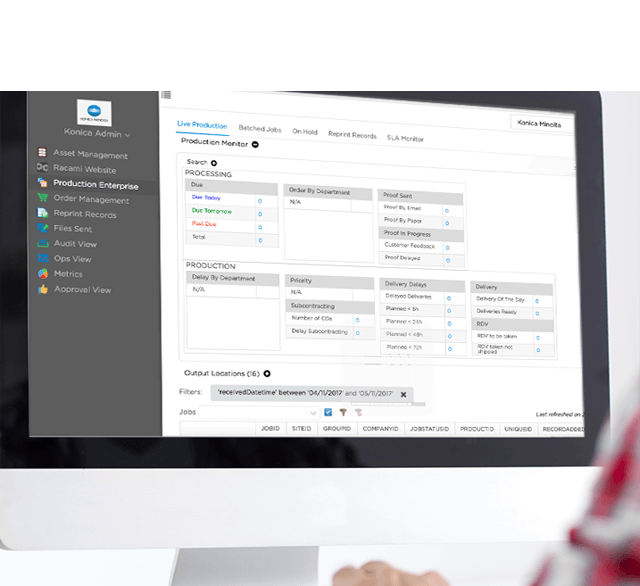In the rapidly evolving print industry, modern technology is revolutionizing direct mail processing. The transformation to inkjet technology from traditional offset and toner-based environments necessitates a reevaluation of pre- and post-processing strategies to fully leverage the capabilities of high-speed inkjet equipment. By optimizing workflows and eliminating unnecessary steps, print operations can achieve significant efficiency gains, streamline processes and enhance overall productivity. This article explores the impact of automation, digital commingling and advanced workflow techniques on the print industry, highlighting how these innovations are reshaping direct mail processing for greater efficiency and effectiveness.

With inkjet technology now accounting for a large portion of work previously handled by offset and toner-based environments, modern technology is significantly transforming the print industry. As industrial inkjet adoption increases, print operations must rethink both pre- and post-processing strategies. Historically, efficiency improvements focused on accelerating each individual process within the value stream. However, with the advent of high-speed industrial inkjet equipment, optimizing workflows to leverage digital technology leads to even greater efficiency gains by eliminating unnecessary process steps.
Initially, digital print engines placed a heavy emphasis on late-stage editing and prepress, often pushing critical adjustments to the press operator. While this approach has proven effective, it inherently limits automation and overall throughput from a broader value-stream perspective. For example, a press operator engaged in late-stage editing may only be able to manage one or two machines at a time. By eliminating the need for these manual interventions, a single operator can efficiently manage three or four machines, significantly improving productivity and reducing bottlenecks.
The Automation of Workflows
Workflow automation has revolutionized print production, particularly using hot folders, which automatically apply a file’s print parameters when sent to the machine or perform another function. The use of hot folders eliminates repetitive prepress tasks, but automation now extends beyond prepress to encompass both upstream and downstream processes. Automation can be as simple as standardized file naming conventions or as sophisticated as XML or JSON header or standalone information. The key to effective automation lies in understanding the specific processes required to create the final product and eliminating unnecessary touchpoints.
One client leveraging Konica Minolta’s AccurioJet KM-1e LED UV press has made a significant leap by transitioning from a multi process offset-based production process of printing, warehousing and inkjet addressing workflow to an automated mail merge digital commingled workflow. This transformation has streamlined efficiencies across the value stream while greatly reducing lead times and logistical complexities. The enhanced workflow eliminates the need for offset plates, daily press cleanings, background form warehousing, inkjet addressing and redundant drop ship pallet positions, while consolidating multiple mailings for improved efficiency.
Automating Variable Data Merging with Static or Dynamic Background Forms
Konica Minolta’s Industrial Print Team has further enhanced mailing workflows by eliminating complex, manual variable data merging through the use of standardized naming conventions, static libraries and dynamic background forms. This approach provides increased design flexibility, faster processing speeds, improved consistency and stronger brand uniformity. By integrating these techniques, the client is realizing efficiency gains while maintaining high-quality output across varying campaign requirements.
Digital Commingling for Reduced Pallet Positions
The transition to commingling has proven to be an effective strategy for consolidating multiple mailings into fewer pallet positions, optimizing drop shipments and maximizing postal discounts. Instead of processing separate drop shipments for different clients or campaigns, commingling allows mailers to take advantage of bulk discounts, lower freight costs and streamlined USPS logistics. By reducing the number of pallet positions, print operations can enhance efficiency, minimize overall mailing expenses and eliminate redundant sorting and handling steps.
Dynamically Generating Postal Tray Identifiers
Traditionally, postal tray identifiers were embedded within inserter Optical Mark Recognition (OMR) marks, barcodes or control files—methods that remain in use today. Inkjet-addressing machines historically altered belt speeds or physically offset the transport belt to create distinct separations. However, today’s direct mail landscape consists of highly targeted, lower-volume postcard or inserted mail pieces, often paired with response-driven QR codes. While digital print engines eliminate the need for inkjet addressing, this shift often introduces downstream inefficiencies, requiring staff to manually sort stacks by searching for hash marks or tray changes.
This issue is easily addressed by incorporating a visible tray identifier, appearing as a bleed edge within the cut stack. For example, in the case of postcards—which are typically hand-trayed due to their format—one mailer has benefited significantly from automated tray identification. This approach allows operators to visually detect tray transitions, reduce sorting errors and improve traceability within the mailing workflow, further streamlining operations.
A Fully Integrated Approach to Mailing Efficiency
By incorporating automated data merging techniques, digital commingling and dynamic postal tray identification, customers have significantly enhanced efficiency, reduced costs and improved accuracy across the entire value stream. These innovations not only streamline mail processing but also minimize waste, reduce production time and create a seamless workflow that meets the evolving demands of modern mailing operations while eliminating unnecessary process steps.
Learn about Konica Minolta’s advanced production workflow automation advancements.